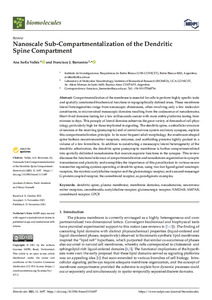Por favor, use este identificador para citar o enlazar este ítem:
https://repositorio.uca.edu.ar/handle/123456789/13059| Título: | Nanoscale sub-compartmentalization of the dendritic spine compartment | Autor: | Vallés, Ana Sofía Barrantes, Francisco José |
Palabras clave: | MEMBRANA CELULAR; NEUROTRANSMISORES; CANNABINOIDES; RECEPTORES | Fecha de publicación: | 2021 | Editorial: | MDPI | Cita: | Vallés, A.S., Barrantes, F.J. Nanoscale sub-compartmentalization of the dendritic spine compartment [en línea]. Biomolecules. 2021, 11(11) doi:10.3390/biom11111697 Disponible en: https://repositorio.uca.edu.ar/handle/123456789/13059 | Resumen: | Abstract: Compartmentalization of the membrane is essential for cells to perform highly specific tasks and spatially constrained biochemical functions in topographically defined areas. These membrane lateral heterogeneities range from nanoscopic dimensions, often involving only a few molecular constituents, to micron-sized mesoscopic domains resulting from the coalescence of nanodomains. Short-lived domains lasting for a few milliseconds coexist with more stable platforms lasting from minutes to days. This panoply of lateral domains subserves the great variety of demands of cell physiology, particularly high for those implicated in signaling. The dendritic spine, a subcellular structure of neurons at the receiving (postsynaptic) end of central nervous system excitatory synapses, exploits this compartmentalization principle. In its most frequent adult morphology, the mushroom-shaped spine harbors neurotransmitter receptors, enzymes, and scaffolding proteins tightly packed in a volume of a few femtoliters. In addition to constituting a mesoscopic lateral heterogeneity of the dendritic arborization, the dendritic spine postsynaptic membrane is further compartmentalized into spatially delimited nanodomains that execute separate functions in the synapse. This review discusses the functional relevance of compartmentalization and nanodomain organization in synaptic transmission and plasticity and exemplifies the importance of this parcelization in various neurotransmitter signaling systems operating at dendritic spines, using two fast ligand-gated ionotropic receptors, the nicotinic acetylcholine receptor and the glutamatergic receptor, and a second-messenger G-protein coupled receptor, the cannabinoid receptor, as paradigmatic examples. | URI: | https://repositorio.uca.edu.ar/handle/123456789/13059 | ISSN: | 2218-273X | Disciplina: | MEDICINA | DOI: | 10.3390/biom11111697 | Derechos: | Acceso abierto | Fuente: | Biomolecules. 2021, 11(11) |
| Aparece en las colecciones: | Artículos |
Ficheros en este ítem:
| Fichero | Descripción | Tamaño | Formato | |
|---|---|---|---|---|
| nanoscale-sub-compartmentalization.pdf | 8,21 MB | Adobe PDF |  Visualizar/Abrir |
Visualizaciones de página(s)
71
comprobado en 27-abr-2024
Descarga(s)
70
comprobado en 27-abr-2024
Google ScholarTM
Ver en Google Scholar
Altmetric
Altmetric
Este ítem está sujeto a una Licencia Creative Commons

